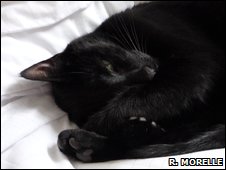| ||||||||||||||||||||||||||||||||||||||||||||||||||||||||||||||||||||||||||||||||||||||||||||||||||||||||||||||||||||||||||||||||||||||||
|
Cat owners may have suspected as much, but it seems our feline1 friends have found a way to manipulate us humans. 养猫的人可能已经怀疑了,看起来我们的猫科动物朋友找到了一种控制人类的方法。 Researchers at the University of Sussex have discovered that cats use a "soliciting2(请求,祈求) purr(咕噜咕噜声)" to overpower(击败,打胜) their owners and garner3(储藏,积累) attention and food. Unlike regular purring, this sound incorporates(合并,具体表现) a "cry", with a similar frequency to a human baby's. The team said cats have "tapped into" a human bias4(人为偏倚) - producing a sound that humans find very difficult to ignore. Dr Karen McComb, the lead author of the study that was published in the journal Current Biology, said the research was inspired(有创见的) by her own cat, Pepo. "He would wake me up in the morning with this insistent5 purr that was really rather annoying," Dr McComb told BBC News. "After a little bit of investigation6, I discovered that there are other cat owners who are similarly bombarded(炮击) early in the morning." While meowing(猫叫声) might get a cat expelled(驱逐,开除) from the bedroom, Dr McComb said that this pestering7(使烦恼,使苦恼) purr often convinced beleaguered8(围攻) pet lovers to get up and fill their cat's bowl. To find out why, her team had to train cat owners to make recordings10 of their own cats' vocal11 tactics(策略,战术) - recording9 both their "soliciting purrs" and regular, "non-soliciting" purrs. "When we played the recordings to human volunteers, even those people with no experience of cats found the soliciting purrs more urgent and less pleasant," said Dr McComb. How annoying? She and her team also asked the volunteers to rate the different purrs - giving them a score based on how urgent and pleasant they perceived(觉察,感觉) them to be. "We could then relate the scores back to the specific purrs," explained Dr McComb. "The key thing (that made the purrs more unpleasant and difficult to ignore) was the relative level of this embedded13 high-frequency sound." "When an animal vocalises, the vocal folds (or cords) held across the stream of air snap shut at a particular frequency," explained Dr McComb. The perceived pitch of that sound depends on the size, length and tension of the vocal folds. "But cats are able to produce a low frequency purr by activating14 the muscles of their vocal folds - stimulating15 them to vibrate," explained Dr McComb. Since each of these sounds is produced by a different mechanism16, cats are able to embed12(使插入,使嵌入) a high-pitched cry in an otherwise relaxing purr. "How urgent and unpleasant the purr is seems to depend on how much energy the cat puts into producing that cry," said Dr McComb. Previous studies have found similarities between a domestic cat's cry and the cry of a human baby - a sound that humans are highly sensitive to. Dr McComb said that the cry occurs at a low level in cats' normal purring. "But we think that (they) learn to dramatically exaggerate(夸大,夸张) it when it proves effective in generating a response from humans." She added that the trait seemed to most often develop in cats that have a one-on-one relationship with their owners. "Obviously we don't know what's going on inside their minds," said Dr McComb. "But they learn how to do this, and then they do it quite deliberately17(故意地)." So how does Dr McComb feel about Pepo now she knows he has been manipulating her all these years? "He's been the inspiration for this whole study, so I'll forgive him - credit where credit's due." 点击  收听单词发音 收听单词发音
|
||||||||||||||||||||||||||||||||||||||||||||||||||||||||||||||||||||||||||||||||||||||||||||||||||||||||||||||||||||||||||||||||||||||||
- 发表评论
-
- 最新评论 进入详细评论页>>




